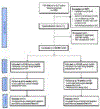Effect of Multicomponent Home-Based Training on Gait and Muscle Strength in Older Adults After Hip Fracture Surgery: A Single Site Randomized Trial
- PMID: 36087806
- PMCID: PMC10039715
- DOI: 10.1016/j.apmr.2022.08.974
Effect of Multicomponent Home-Based Training on Gait and Muscle Strength in Older Adults After Hip Fracture Surgery: A Single Site Randomized Trial
Abstract
Objective: To investigate the effect of 16-week home-based physical therapy interventions on gait and muscle strength.
Design: A single-blinded randomized controlled trial.
Setting: General community.
Participants: Thirty-four older adults (N=34) post hip fracture were randomly assigned to either experimental group (a specific multi-component intervention group [PUSH], n=17, 10 women, age=78.6±7.3 years, 112.1±39.8 days post-fracture) or active control (a non-specific multi-component intervention group [PULSE], n=17, 11 women, age=77.8±7.8 years, 118.2±37.5 days post-fracture).
Intervention: PUSH and PULSE groups received 32-40 sessions of specific or non-specific multi-component home-based physical therapy, respectively. Training in the PUSH group focused on lower extremity strength, endurance, balance, and function for community ambulation, while the PULSE group received active movement and transcutaneous electrical nerve stimulation on extremities.
Main outcome measures: Gait characteristics, and ankle and knee muscle strength were measured at baseline and 16 weeks. Cognitive testing of Trail Making Test (Part A: TMT-A; Part-B: TMT-B) was measured at baseline.
Results: At 16 weeks, both groups demonstrated significant increases in usual (P<.05) and fast (P<.05) walking speed, while there was no significant difference in increases between the groups. There was only 1 significant change in lower limb muscle strength over time (non-fractured side) between the groups, such that PUSH did better (mean: 4.33%, 95% confidence interval:1.43%-7.23%). The increase in usual and fast walking speed correlated with the baseline Trail-making Test-B score (r=-0.371, P=.037) and improved muscle strength in the fractured limb (r=0.446, P=.001), respectively.
Conclusion: Gait speed improved in both home-based multicomponent physical therapy programs in older adults after hip fracture surgery. Muscle strength of the non-fractured limb improved in the group receiving specific physical therapy training. Specific interventions targeting modifiable factors such as muscle strength and cognitive performance may assist gait recovery after hip fracture surgery.
Trial registration: ClinicalTrials.gov NCT01783704.
Keywords: Exercise Therapy; Gait; Hip fractures; Muscle strength; Rehabilitation.
Copyright © 2022 American Congress of Rehabilitation Medicine. Published by Elsevier Inc. All rights reserved.
Figures

References
-
- Magaziner J, Hawkes W, Hebel JR, Zimmerman SI, Fox KM, Dolan M, Felsenthal G, Kenzora J. Recovery from hip fracture in eight areas of function. The Journals of Gerontology Series A: Biological Sciences and Medical Sciences 2000;55(9):M498–M507. - PubMed
-
- McDonough CM, Harris-Hayes M, Kristensen MT, Overgaard JA, Herring TB, Kenny AM, Mangione KK. Physical therapy management of older adults with hip fracture: clinical practice guidelines linked to the international classification of functioning, disability and health from The Academy of Orthopaedic Physical Therapy and The Academy of Geriatric Physical Therapy of The American Physical Therapy Association. Journal of Orthopaedic & Sports Physical Therapy 2021;51(2):CPG1-CPG81. - PubMed
-
- Kuijlaars IA, Sweerts L, Nijhuis-van der Sanden MW, van Balen R, Staal JB, van Meeteren NL, Hoogeboom TJ. Effectiveness of supervised home-based exercise therapy compared to a control intervention on functions, activities, and participation in older patients after hip fracture: a systematic review and meta-analysis. Arch Phys Med Rehabil 2019;100(1):101–14.e6. - PubMed
Publication types
MeSH terms
Associated data
Grants and funding
LinkOut - more resources
Full Text Sources
Medical

